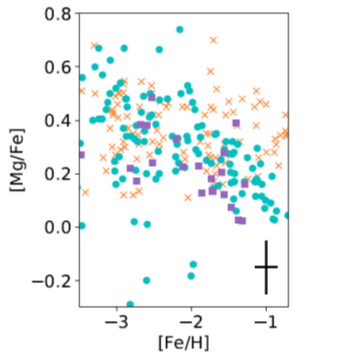February 25, 2020
Seeking a signature of galaxy accretions - The chemical abundance of highly-retrograde stars
SOKENDAI Publication Grant for Research Papers program year: 2019
MATSUNO Tadafumi, Astronomical Science
Origin of the Excess of High-energy Retrograde Stars in the Galactic Halo
Journal: Astrophysical Journal Letters publish year: 2019
DOI: 10.3847/2041-8213/ab0ec0

The highly-retrograde stars are shown in purple squares in the figure. The Mg/Fe ratio of these stars are lower on average at -2 < [Fe/H]<-1 than the other components in Milky Way (blue circles or orange crosses). The size of error is shown by the black cross.
TGalaxies including the Milky Way are predicted to have evolved through accretions or mergers of galaxies. Therefore, finding signatures of such events is of particular importance to test our understanding of galaxy formation processes. In the case of the Milky Way, accretion signatures can be searched for from the distribution of stellar kinematics. Previous studies have found a kinematic over-density, a group of stars orbiting in the opposite direction to the Galactic disk with a very large speed (highly-retrograde stars), which might be a signature of past galaxy accretion. However, independent information such as chemical abundance of stars, which is needed to confirm their origin clearly, remains unclear.
We used a chemical abundance database that has been compiling past abundance measurements for stars. We selected highly-retrograde stars from the database and compared their chemical abundances to other stellar populations in the Galaxy. As shown in the figure, the highly-retrograde stars have lower Mg abundances, strongly supporting that their origin is an accretion of a galaxy.
Our results show that accretions have played an important role in the formation of Milky Way-like galaxies. However, the number of galaxies accreted onto the Milky Way should not be just one or two, according to model predictions. Search for kinematic over-densities is extensively being conducted in recent years by using data from the ongoing space mission, Gaia. In a few years, many kinematic over-densities will be discovered. As we conducted in this study, detailed investigation of their chemical abundances would tell us their origin.
Astrophysical Journal Letters, published on April 8 2019
"Origin of the Excess of High-energy Retrograde Stars in the Galactic Halo"
Matsuno, Tadafumi; Aoki, Wako; Suda, Takuma.
Doi: https://doi.org/10.3847/2041-8213/ab0ec0
Tadafumi MATSUNO, School of Physical Science, Dept. Astronomical Science
